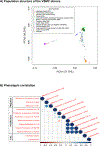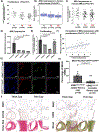Genetic Regulation of Atherosclerosis-Relevant Phenotypes in Human Vascular Smooth Muscle Cells
- PMID: 33040646
- PMCID: PMC7718324
- DOI: 10.1161/CIRCRESAHA.120.317415
Genetic Regulation of Atherosclerosis-Relevant Phenotypes in Human Vascular Smooth Muscle Cells
Abstract
Rationale: Coronary artery disease (CAD) is a major cause of morbidity and mortality worldwide. Recent genome-wide association studies revealed 163 loci associated with CAD. However, the precise molecular mechanisms by which the majority of these loci increase CAD risk are not known. Vascular smooth muscle cells (VSMCs) are critical in the development of CAD. They can play either beneficial or detrimental roles in lesion pathogenesis, depending on the nature of their phenotypic changes.
Objective: To identify genetic variants associated with atherosclerosis-relevant phenotypes in VSMCs.
Methods and results: We quantified 12 atherosclerosis-relevant phenotypes related to calcification, proliferation, and migration in VSMCs isolated from 151 multiethnic heart transplant donors. After genotyping and imputation, we performed association mapping using 6.3 million genetic variants. We demonstrated significant variations in calcification, proliferation, and migration. These phenotypes were not correlated with each other. We performed genome-wide association studies for 12 atherosclerosis-relevant phenotypes and identified 4 genome-wide significant loci associated with at least one VSMC phenotype. We overlapped the previously identified CAD loci with our data set and found nominally significant associations at 79 loci. One of them was the chromosome 1q41 locus, which harbors MIA3. The G allele of the lead risk single nucleotide polymorphism (SNP) rs67180937 was associated with lower VSMC MIA3 expression and lower proliferation. Lentivirus-mediated silencing of MIA3 (melanoma inhibitory activity protein 3) in VSMCs resulted in lower proliferation, consistent with human genetics findings. Furthermore, we observed a significant reduction of MIA3 protein in VSMCs in thin fibrous caps of late-stage atherosclerotic plaques compared to early fibroatheroma with thick and protective fibrous caps in mice and humans.
Conclusions: Our data demonstrate that genetic variants have significant influences on VSMC function relevant to the development of atherosclerosis. Furthermore, high MIA3 expression may promote atheroprotective VSMC phenotypic transitions, including increased proliferation, which is essential in the formation or maintenance of a protective fibrous cap.
Keywords: cell proliferation; coronary artery disease; genome-wide association study; human genetics.
Figures





References
-
- Frismantiene A, Philippova M, Erne P, Resink TJ. Smooth muscle cell-driven vascular diseases and molecular mechanisms of VSMC plasticity. Cellular Signalling. 2018;52:48–64. - PubMed
-
- Benjamin EJ, Virani SS, Callaway CW, et al. Heart Disease and Stroke Statistics—2018 Update: A Report From the American Heart Association. Circulation. 2018;137:e67–e492. - PubMed
-
- McPherson R, Tybjaerg-Hansen A. Genetics of Coronary Artery Disease. Circ Res. 2016;118:564–78. - PubMed
Publication types
MeSH terms
Substances
Grants and funding
LinkOut - more resources
Full Text Sources
Medical
Miscellaneous

